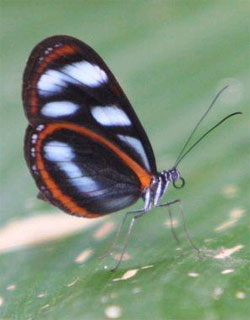Female butterflies become more promiscuous when males are scarce
Female butterflies become more promiscuous when males are scarce
mongabay.com
February 5, 2007
Female butterflies become more promiscuous when males die from bacteria outbreaks, according to a new study published in the journal Current Biology. The research suggests that surviving males have a tough time keeping up their frisky mates, showing “signs of fatigue and put less effort into mating.”
“Male-killling bacteria are found in many insect species including the British ladybird. We wanted to know what the effect of the bacteria is on the mating system, and here we’ve shown that butterfly mating patterns are strongly determined by the killer bacteria.” said Dr. Sylvain Charlat, a biologist from University College London and lead author of the study.
 Research was not conducted on this species of butterfly which hails from Colombia. An Asian species, Hypolimnas bolina, was used for the study.  Sylvain Charlat. |
“Contrary to expectation, we also find that female promiscuity actually rises when male numbers are reduced,” he continued. “Greater numbers of female partners leads to fatigue in males. They start producing smaller sperm packages. Unfortunately, the female butterflies instinctively know that the packages are smaller and that their chances of having been impregnated after mating are lower than usual. This just makes them more rampant!”
“It’s amazing that the numbers of male butterflies can get so low and yet the population is still sustainable and stable. You don’t need many male butterflies to continue the population successfully. This is partly because the decision to mate is mainly under female control and because males have a high mating capacity,” added Dr. Greg Hurst, a co-author of the study and also a biologist from University College London.
This study was conducted on Hypolimnas bolina butterflies in Pacific Island and southeast Asian populations.
This article is based on a news release from University College London